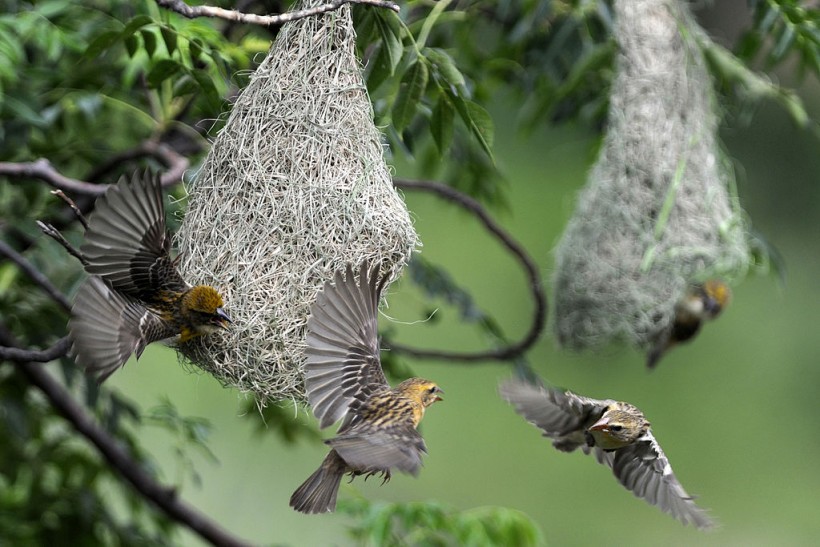A new biological study on weaver birds shows a comprehensive perspective on the association between their social behavior, habitat, and diet. The link that connects these aspects was first theorized in 1964 by ethology expert John Crook.
After almost six decades, the concept was proven with factual evidence observed from the weaver birds.
Biology and Behavior of Weaver Birds

Weaver birds flutter near their nests hanging from a tree in Kathmandu on June 21, 2012. Weavers, small passerine birds related to finches, are one of some 868 species of birds found in Nepal. The country's diverse topography and climate is home to more than ten percent of the world's bird species.
The weaver birds are unique avian species that curate their habitats in the most elaborate way. These birds are known to build unique nests that are more complex compared to other species.
The waver birds are part of the diverse group of songbirds. The weaver birds are exclusively found in the regions of sub-Saharan Africa. Due to their nest-building skills, weaver birds have the capability to live in any environment possible such as forests and savannas, Earth reports.
Through previous papers that focused on weaver birds' exemplary nature, the authors of the new study found an unusual trend. According to the experts, weaver bird groups that live in green forests consist of solitary hunters that are fond of monogamous pairing, while those found in savannas nests in colonies and demonstrate polygamous behaviors.
University of Bath's Milner Center for Evolution expert Tamas Szekely and colleagues led the new study on weaver birds and their biology. The main interest of the research is to identify what are the common grounds between these avians' habitat, social behavior, and dietary choices.
ALSO READ: Monkeys Found to Consume Alcohol; Hints Human Passion for Booze
Social Life Influence Diet Choice of Weaver Birds Living in Forest and Savanna
Szekely explained that the weaver birds that prefer eating seeds tend to live in the open savanna, where they could flock together and find their favorite foods effectively by numbers. Moreover, flocking lowers the tendency of their members to be chased by predators.
The downside of the open savanna habitats is that it offers a limited number of spaces for nesting. This situation requires the weaver birds to live in colonies and pushes them to undergo polygamous breeding, Szekely continued.
The forest groups, on the other hand, lean more on insect diets. This choice requires them to hunt for their prey in larger areas. The setup of the forests provides a closer and safer territory, giving weaver birds numerous areas to build their individual nests.
Weaver birds that live in forests often stay with the same partner during the breeding periods, contrary to the social system present in the savanna population.
Crook's theories over the biological aspect of weaver birds served as the foundation to collect the recent findings in the new study. However, the authors of this separate paper also found other aspects that were not observed before.
For example, the habitat and diet of weaver birds are influenced if an individual is dimorphic. The majority of savanna weaver birds that are confirmed as polygamous species are most likely dimorphic, while the monogamous forest group has identical males and females.
The study was published in The American Naturalist, titled "Evolution of social organization: phylogenetic analyses of ecology and sexual selection in weavers."
RELATED ARTICLE: Tropic Birds More Colorful Than Avians Away from Equator, Studies Suggest
Check out more news and information on Biology in Science Times.




![Earth's Quasi-Moon Kamo‘oalewa Could Originate From Lunar Surface Not Asteroid Belt [Study]](https://1721181113.rsc.cdn77.org/data/thumbs/full/53275/89/56/50/40/earths-quasi-moon-kamo-oalewa-could-originate-from-lunar-surface-not-asteroid-belt-study.png)









